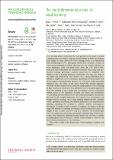Files in this item
The multi-dimensional nature of vocal learning
Item metadata
| dc.contributor.author | Vernes, Sonja | |
| dc.contributor.author | Kriengwatana, Buddhamas Pralle | |
| dc.contributor.author | Beeck, Veronika | |
| dc.contributor.author | Fischer, Julia | |
| dc.contributor.author | Tyack, Peter Lloyd | |
| dc.contributor.author | ten Cate, Carel | |
| dc.contributor.author | Janik, Vincent M. | |
| dc.date.accessioned | 2021-09-07T09:30:10Z | |
| dc.date.available | 2021-09-07T09:30:10Z | |
| dc.date.issued | 2021-10-25 | |
| dc.identifier | 274299666 | |
| dc.identifier | dc8ce0d1-ec30-4493-9efa-b8314f9b2824 | |
| dc.identifier | 000693558500003 | |
| dc.identifier | 85115818216 | |
| dc.identifier.citation | Vernes , S , Kriengwatana , B P , Beeck , V , Fischer , J , Tyack , P L , ten Cate , C & Janik , V M 2021 , ' The multi-dimensional nature of vocal learning ' , Philosophical Transactions of the Royal Society. B, Biological Sciences , vol. 376 , no. 1836 , 20200236 . https://doi.org/10.1098/rstb.2020.0236 | en |
| dc.identifier.issn | 0962-8436 | |
| dc.identifier.uri | https://hdl.handle.net/10023/23911 | |
| dc.description | Funding; S.C.V. was supported by a Max Planck Research Group (MPRG), a Human Frontiers Science Program (HFSP) Research grant (grant no. RGP0058/2016) and a UKRI Future Leaders Fellowship (grant no. MR/T021985/1). P.L.T. was supported by US Office of Naval Research (ONR) grant nos N00014-18-1-2062 and N00014-20-1-2709. B.P.K. was supported by the European Union's Horizon 2020 research and innovation programme under the Marie Skłodowska-Curie grant agreement no. 751356. V.C.B. was supported by the DK Cognition and Communication by the Austrian Science Fund (FWF) grant no. W1262-B29. | en |
| dc.description.abstract | How learning affects vocalizations is a key question in the study of animal communication and human language. Parallel efforts in birds and humans have taught us much about how vocal learning works on a behavioural and neurobiological level. Subsequent efforts have revealed a variety of cases among mammals in which experience also has a major influence on vocal repertoires. Janik and Slater (Anim. Behav.60, 1–11. (doi:10.1006/anbe.2000.1410)) introduced the distinction between vocal usage and production learning, providing a general framework to categorize how different types of learning influence vocalizations. This idea was built on by Petkov and Jarvis (Front. Evol. Neurosci.4, 12. (doi:10.3389/fnevo.2012.00012)) to emphasize a more continuous distribution between limited and more complex vocal production learners. Yet, with more studies providing empirical data, the limits of the initial frameworks become apparent. We build on these frameworks to refine the categorization of vocal learning in light of advances made since their publication and widespread agreement that vocal learning is not a binary trait. We propose a novel classification system, based on the definitions by Janik and Slater, that deconstructs vocal learning into key dimensions to aid in understanding the mechanisms involved in this complex behaviour. We consider how vocalizations can change without learning, and a usage learning framework that considers context specificity and timing. We identify dimensions of vocal production learning, including the copying of auditory models (convergence/divergence on model sounds, accuracy of copying), the degree of change (type and breadth of learning) and timing (when learning takes place, the length of time it takes and how long it is retained). We consider grey areas of classification and current mechanistic understanding of these behaviours. Our framework identifies research needs and will help to inform neurobiological and evolutionary studies endeavouring to uncover the multi-dimensional nature of vocal learning. | |
| dc.format.extent | 15 | |
| dc.format.extent | 554429 | |
| dc.language.iso | eng | |
| dc.relation.ispartof | Philosophical Transactions of the Royal Society. B, Biological Sciences | en |
| dc.subject | Vocal learning | en |
| dc.subject | Songbird | en |
| dc.subject | Cognition | en |
| dc.subject | Behaviour | en |
| dc.subject | Evolution | en |
| dc.subject | Language | en |
| dc.subject | QH301 Biology | en |
| dc.subject | QL Zoology | en |
| dc.subject | T-DAS | en |
| dc.subject.lcc | QH301 | en |
| dc.subject.lcc | QL | en |
| dc.title | The multi-dimensional nature of vocal learning | en |
| dc.type | Journal item | en |
| dc.contributor.sponsor | UK Research and Innovation | en |
| dc.contributor.institution | University of St Andrews. St Andrews Bioinformatics Unit | en |
| dc.contributor.institution | University of St Andrews. School of Biology | en |
| dc.contributor.institution | University of St Andrews. Sea Mammal Research Unit | en |
| dc.contributor.institution | University of St Andrews. Marine Alliance for Science & Technology Scotland | en |
| dc.contributor.institution | University of St Andrews. Scottish Oceans Institute | en |
| dc.contributor.institution | University of St Andrews. Institute of Behavioural and Neural Sciences | en |
| dc.contributor.institution | University of St Andrews. Centre for Social Learning & Cognitive Evolution | en |
| dc.contributor.institution | University of St Andrews. Bioacoustics group | en |
| dc.identifier.doi | https://doi.org/10.1098/rstb.2020.0236 | |
| dc.description.status | Peer reviewed | en |
| dc.identifier.grantnumber | MR/T021985/1 | en |
This item appears in the following Collection(s)
Items in the St Andrews Research Repository are protected by copyright, with all rights reserved, unless otherwise indicated.

